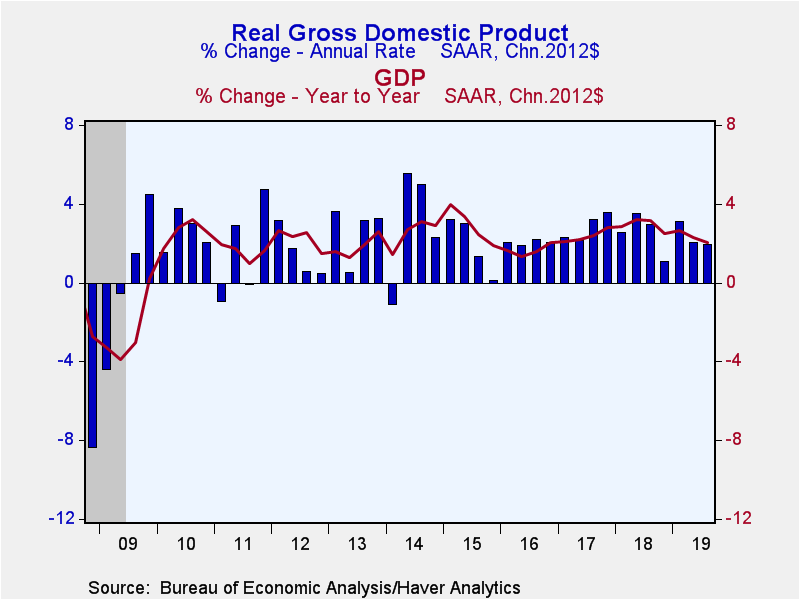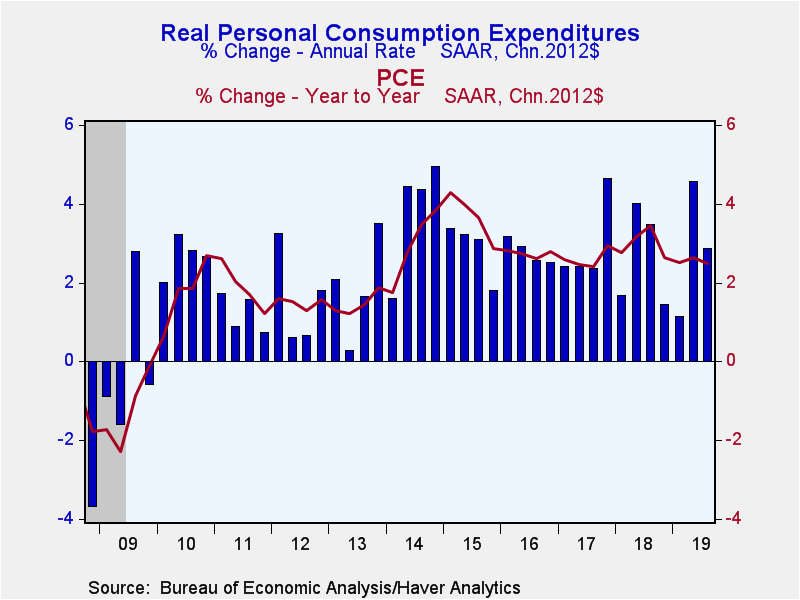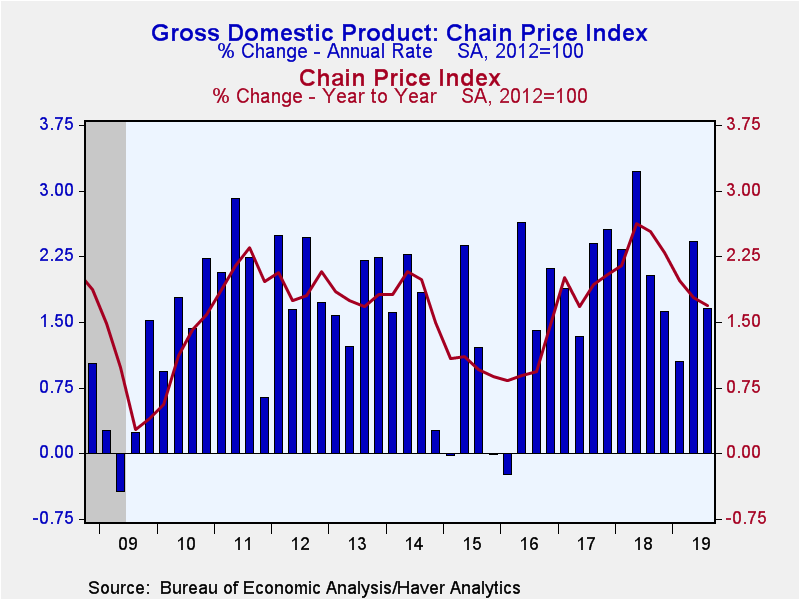 Global| Oct 30 2019
Global| Oct 30 2019U.S. GDP Growth Dips As Demand Growth Weakens
by:Tom Moeller
|in:Economy in Brief
Summary
Economic growth eased during Q3'19 to 1.9% from 2.0% in the second quarter. A 1.5% rise had been expected in the Action Economics Forecast Survey. The slowdown lowered growth over the last four quarters to 2.0%, its weakest since the [...]
Economic growth eased during Q3'19 to 1.9% from 2.0% in the second quarter. A 1.5% rise had been expected in the Action Economics Forecast Survey. The slowdown lowered growth over the last four quarters to 2.0%, its weakest since the end of 2016.
The slip in growth was the result of a slowdown in domestic final sales growth to 2.0% from 3.6% in Q2. Growth in personal spending slackened to 2.9% (2.5% y/y), but it remained on par with growth during the last three years. Durable goods buying remained strong and posted a 7.6% rise (5.4% y/y) after a 13.0% jump. Purchases of recreational goods & vehicles surged 17.5% (12.2% y/y), the third consecutive quarter of double-digit growth. Spending on motor vehicles rose 0.7% (1.9% y/y) following a 16.1% jump, fueled by sales incentives. Home furnishings & appliance buying rose a strong 6.3% (2.9% y/y) after a 9.0% improvement. Nondurable goods buying increased 4.4% (3.7% y/y) after a 6.5% jump. Spending on food & beverages rose 6.8% (2.9% y/y) after a 5.3% rise, but apparel buying eased 0.4% (+2.4% y/y) in the wake of a 14.5% surge. Spending on services improved 1.7% both q/q and y/y following a 2.8% rise. Health care outlays rose 1.7% (2.4%) following much stronger growth during the prior two quarters. Restaurant & hotel spending increased 2.8% and by a sharply reduced 0.9% y/y. Recreation spending edged 0.4% lower (+2.0% y/y) following a 6.4% jump.
Fixed business investment declined 3.0% (+1.3% y/y), down for the second consecutive quarter. It was dragged lower by a 15.3% decline (-8.1% y/y) in spending on structures which followed an 11.1% drop. Equipment investment also declined by 3.8% (+1.0% y/y), the first material quarterly decline in three years. It was prompted by a 7.3% weakening (+1.5% y/y) in information processing equipment investment which was the largest quarterly decline in roughly eight years. Industrial equipment demand rose an improved 7.0% (2.8% y/y). Intellectual property product investment rose 6.6% (8.1% y/y) as software spending rose by roughly one-third (40.8% y/y).
Residential investment rose 5.1% (-1.0% y/y), the first increase since Q4'17.
Government spending improved 2.0% (2.3% y/y), less than half the prior quarter's increase. The slowdown occurred as federal government spending rose 3.4% (3.7% y/y) following an 8.3% jump. Nondefense outlays strengthened 5.2% (2.5% y/y) last quarter after a 16.1% jump. Defense spending rose 2.1% (4.5% y/y), the weakest increase since Q1'18. Spending by state & local governments improved 1.1% (1.5% y/y) following a 2.7% rise.
Inventory decumulation reduced GDP growth by a lessened 0.1 percentage point after a 0.8 point drag in Q2. Deterioration in the foreign trade deficit sapped 0.8 percentage points from GDP growth, slightly more than the 0.7 point Q2 subtraction. Exports grew 0.7% (0.1% y/y) following a 5.7% decline. Imports rose 1.2% (0.8% y/y) following little change during Q2.
The GDP price index rose a lessened 1.7%, and the y/y increase slowed to 1.7% from 2.8% early last year. The PCE price index rose 1.5% (1.4% y/y) after a 2.4% gain, but prices excluding food & energy rose 2.2% (1.7% y/y), double he Q1'19 rise. The business fixed investment price index rose a reduced 0.6% and a fairly steady 1.1% y/y. The residential investment price index strengthened 3.3% but the y/y increase slowed to 2.5%, the weakest growth since early 2016.
The GDP figures can be found in Haver's USECON and USNA database. USNA contains virtually all of the Bureau of Economic Analysis' detail in the national accounts. Both databases include tables of the newly published not seasonally adjusted data. The Action Economics consensus estimates can be found in AS1REPNA.
| Chained 2012 $ (%, AR) | Q3'19 (Advance Estimate) | Q2'19 | Q1'19 | Q3'19 Y/Y | 2018 | 2017 | 2016 |
|---|---|---|---|---|---|---|---|
| Gross Domestic Product | 1.9 | 2.0 | 3.1 | 2.0 | 2.9 | 2.4 | 1.9 |
| Inventory Effect (%-point) | -0.1 | -0.9 | 0.5 | -0.1 | 0.1 | 0.1 | -0.3 |
| Final Sales | 2.0 | 3.0 | 2.6 | 2.1 | 2.8 | 2.3 | 2.2 |
| Foreign Trade Effect (%-point) | -0.8 | -0.7 | 0.7 | -0.1 | -0.2 | -0.2 | -0.2 |
| Domestic Final Sales | 2.0 | 3.6 | 1.8 | 2.2 | 3.0 | 2.5 | 2.4 |
| Personal Consumption Expenditure | 2.9 | 4.6 | 1.1 | 2.5 | 3.0 | 2.6 | 2.7 |
| Nonresidential Fixed Investment | -3.0 | -1.0 | 4.4 | 1.3 | 6.4 | 4.4 | 0.7 |
| Residential Investment | 5.1 | -2.9 | -1.1 | -1.0 | -1.5 | 3.5 | 6.5 |
| Government Spending | 2.0 | 4.8 | 2.9 | 2.3 | 1.7 | 0.7 | 1.8 |
| Chain-Type Price Index | |||||||
| GDP | 1.7 | 2.4 | 1.1 | 1.7 | 2.4 | 1.9 | 1.0 |
| Personal Consumption Expenditure | 1.5 | 2.4 | 0.4 | 1.4 | 2.1 | 1.8 | 1.0 |
| Less Food & Energy | 2.2 | 1.9 | 1.1 | 1.7 | 1.9 | 1.6 | 1.6 |
| Nonresidential Investment | 0.6 | 2.0 | 1.6 | 1.1 | 1.4 | 1.0 | -0.9 |
| Residential Investment | 3.3 | 1.7 | 2.6 | 2.5 | 5.6 | 4.5 | 3.5 |
Tom Moeller
AuthorMore in Author Profile »Prior to joining Haver Analytics in 2000, Mr. Moeller worked as the Economist at Chancellor Capital Management from 1985 to 1999. There, he developed comprehensive economic forecasts and interpreted economic data for equity and fixed income portfolio managers. Also at Chancellor, Mr. Moeller worked as an equity analyst and was responsible for researching and rating companies in the economically sensitive automobile and housing industries for investment in Chancellor’s equity portfolio. Prior to joining Chancellor, Mr. Moeller was an Economist at Citibank from 1979 to 1984. He also analyzed pricing behavior in the metals industry for the Council on Wage and Price Stability in Washington, D.C. In 1999, Mr. Moeller received the award for most accurate forecast from the Forecasters' Club of New York. From 1990 to 1992 he was President of the New York Association for Business Economists. Mr. Moeller earned an M.B.A. in Finance from Fordham University, where he graduated in 1987. He holds a Bachelor of Arts in Economics from George Washington University.












